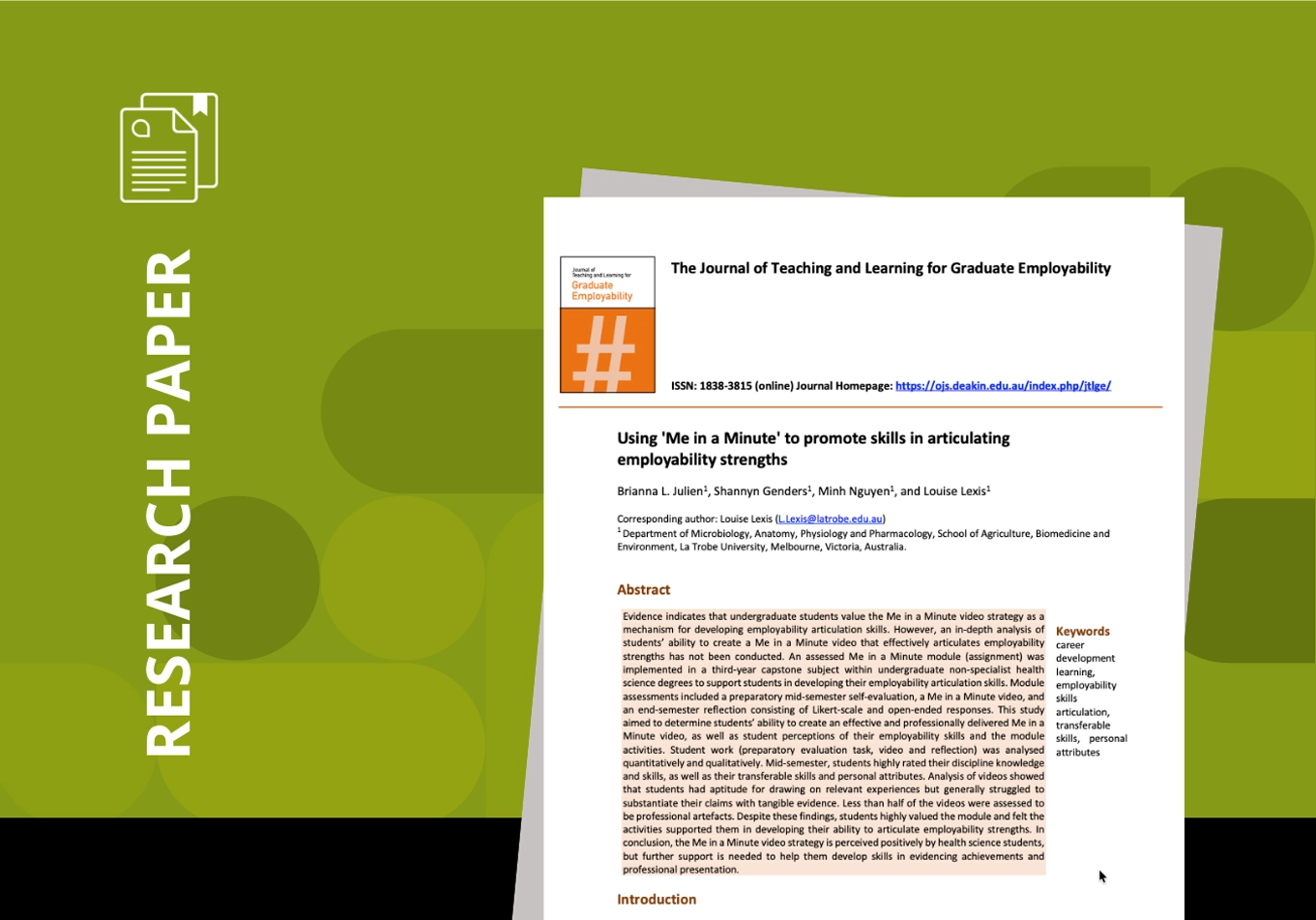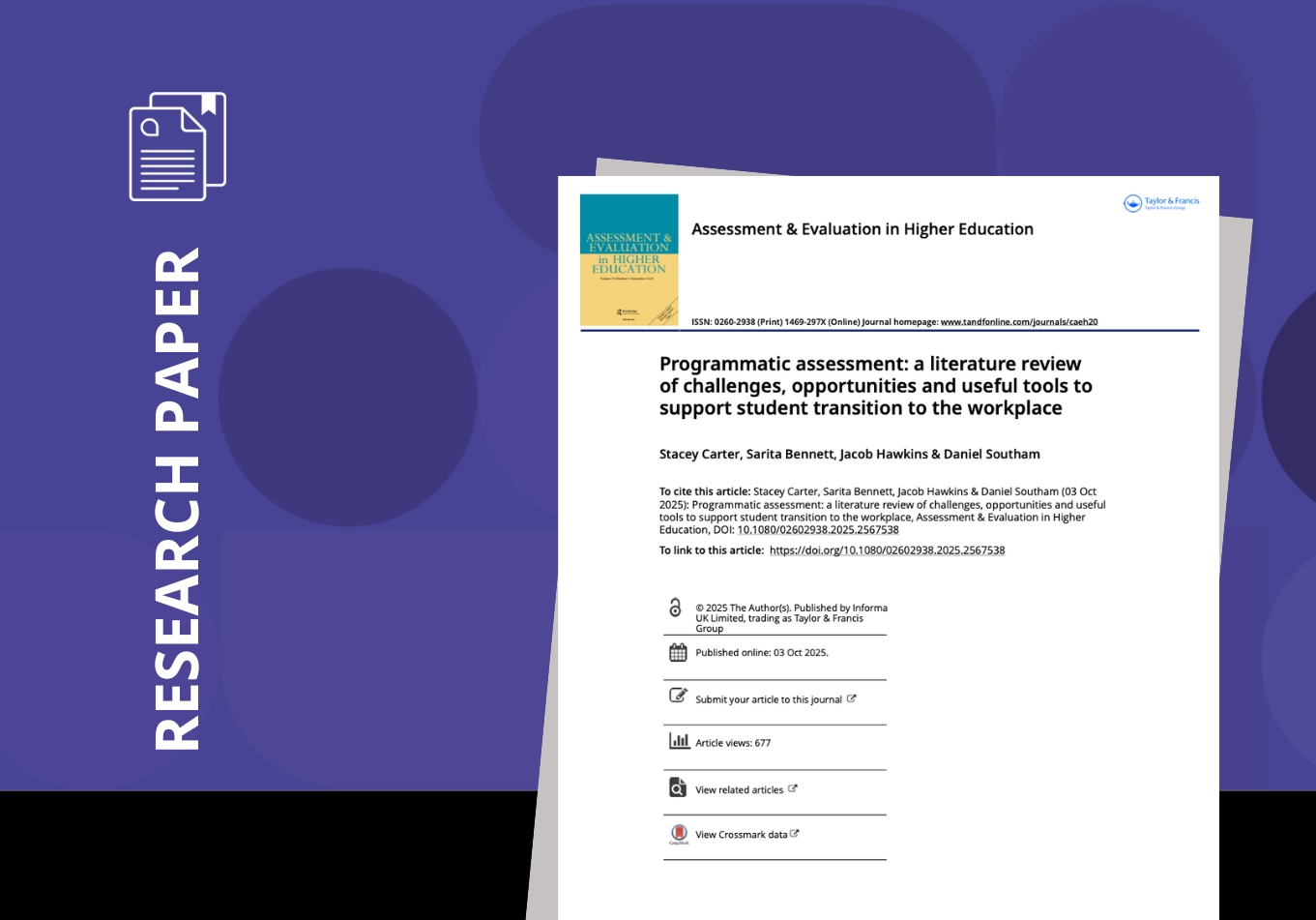We sat down with recent MiniBash presenter, John Egan from the University of Auckland, to dig deeper into his PebblePad implementation experience – and how it is helping his students navigate what he calls the ‘Assessment Valley’.
John Egan’s primary role is Associate Dean, Learning and Teaching in the Faculty of Medical Health Sciences at the University of Auckland. He is also the Director of the Learning and Teaching Unit, providing educational services, and is responsible for the quality of coursework programs in the faculty.
Leveraging his background in sociology and years of experience working with ePortfolio-based assessment, John reveals his team’s journey to implement PebblePad in this exclusive interview – and how it helped overcome the ‘Assessment Valley’ holding students back from fully engaging in their learning journeys.
‘Assessment Valley’: What it is, why it matters
In his 2025 PebblePad MiniBash presentation, John noted that students are in a repetitive cycle – of being stuck in the Assessment Valley. This is where students are so focused on their assessment task, or getting their marks, that there is limited opportunity to help them make genuine connections with their learning experiences.
Can you define the Assessment Valley and how ePortfolio-based assessment has helped negate it?
It’s a real challenge anywhere at a university where students think of the assessment tasks as a series of discrete assessment points, rather than a learning journey. It’s a social phenomenon. As a sociologist, I understand the social entity of the University, or the College, or the Polytech is creating that space, and students are fitting themselves into that space, depending on who they are and what their lived experience is.
My use of the metaphor ‘Assessment Valley’ is purposive because students jump into the valley and you can’t engage with them when they’re in there because they are so focused on the assessment or the results of the assessment. They become cognitively available after they come out of the valley.
The more they go dipping into the valley, the more limited your opportunities are to engage with them substantially as a learner. Getting them out of the valley paradoxically makes it an easier journey [for the students], because going in and out of valleys is exhausting. You’ve got to climb out of it every time.
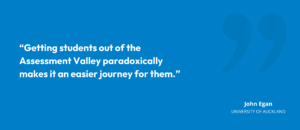
That’s the benefit of a portfolio-based assessment strategy. [It] always has one arm that’s pulling the students out of the valley saying, “look at why we’re having you do this – now think about where you’re going to be using this in the future”. But by doing these program-level assessments – and I don’t know how else you would do that except [with a] portfolio – we allow students to solidly keep one foot in whatever they’re doing in terms of courses or modules.
For example, in a four-year medical program, you have to re-teach the first-year sciences because nobody has retained them from their first year undergrad. Students were in the Assessment Valley with the mindset to get through this test, this quiz, this exam, and we haven’t given a process for them to meaningfully transfer those earlier years learning, so they don’t retain it.
You can appreciate the beauty of a valley and decide intentionally when you want to go to its bottom, rather than constantly finding yourself at the bottom and trying to get out. Then it becomes a valley that’s based on learning, not based on assessment of learning by itself.
Lessons from lived experience
To create the right conditions to navigate the Assessment Valley, John and his team spent years refining what they needed from an ePortfolio platform. Drawing on his experience at the University of British Columbia and a new approach for capstones at the University of Auckland, John explained why deep reflection – and not just assignment submission – is the real game-changer.
Why did you choose PebblePad in 2024 – and what past experiences shaped that decision?
I’ve worked in portfolio-based assessment for a long time, and our decision to adopt PebblePad in 2024 was very deliberate: we were looking for a way to connect learning across the program. Previously, I worked in a program at the University of British Columbia called the Master of Educational Technology (MET).
At the very end, we asked MET students to not just produce a final essay on the academic subject, [instead] we asked them to reflect on what they had learned in the program by doing the various components of the portfolio. It’s that last component – the synthesis reflection essay – that really transformed students’ learning in a portfolio-based assignment.
If you’re only using a platform like PebblePad as a new way for students to submit lots of assignments, you’re really missing an opportunity [to let] students see, over the course of their journey, how their thinking has evolved, how their knowledge has expanded, and how their competencies and skills have developed. These all are massive confidence builders.
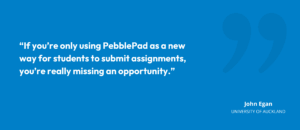
The idea of doing program level assessment is very appealing, but the challenge is that some people think to just add another layer of assessment on top of everything. The University of Auckland [does] a great thing in the undergraduate courses: every third year of a three year undergraduate degree has to have a capstone experience.
The capstone experience could be Work Integrated Learning (WIL), or a capstone course where they’re not taught new content. Students are required to go back through their learning in the rest of the program and then meaningfully talk about what their post-graduation life is going to look like: Are they going to do a postgraduate degree? Are they going to go into a clinical program? Are they going to work in the sector? What kind of roles would they be looking for? Those courses would be well situated to PebblePad.
One size doesn’t fit all
Valley or no valley, delivering education is complex and we all know that there is no standardised approach. For instance, in the Faculty of Medical Health Sciences at University of Auckland, there were different programs and disciplines that had varying levels of experience with ePortfolio approaches and platforms. To address this, John created an ePortfolio approach that could deliver the flexibility needed to overcome pre-existing limitations – and the results have been stellar.
What happens when different programs move over to a shared platform like PebblePad?
In moving to PebblePad this year, there was one program in our faculty where portfolio-based assessment just absolutely soared – our Bachelor of Pharmacy honours program. For over a decade, they have seen how students finishing in fourth year are transformed by their ePortfolio experience. The students really get that they’ve been developing in a holistic learning experience in terms of achieving competence, which is invaluable. They flew through their transition to PebblePad for work-based learning.
Another early adopter, Medical Imaging, weren’t using a portfolio platform per se but leveraging bespoke web objects and reporting. When they were looking at making a change, they said they’d love to be part of the PebblePad project. Their transition has meant re-thinking past practices based on previous limitations, so it has been a different development process.
Recently, we have been working on Nursing pre-registration who have also been doing ePortfolio assessment since 2012. They are PebblePad-ready and keen to redesign workflows and discuss how do things differently and better with the new platform, through an intentional and staged approach.
On a very fundamental level, it is the students’ relationships with lecturers and tutors that is super important. To have cred with the students, the teaching team need to be able to articulate the why they are using a platform, as well as the what and how.
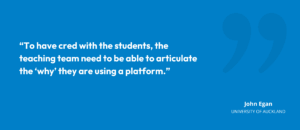
When teaching academics in my Advanced eLearning in Clinical Education course, my goal is for my students to come out of it, saying, “Okay, I understand why this is a not for everything. But for certain things, this is a really, really good approach”. They will come out with a much deeper understanding of assessment of online learning, of e-learning, of blended learning, of the importance of social presence – and are confident they can now take this and ePortfolio-based assessment into their teaching.
Planning for a successful rollout
Working with John over the last year, PebblePad has seen the value in planning out the steps – both small and large – so you know why you’re doing things and understand where you’re going next. It’s a given that you are going to learn things along the way but having a plan and understanding of what it’s going to take from the beginning is also very important.
What were your own lessons learnt from implementing PebblePad in the faculty?
From this project … our key lessons were:
- Protect staff time. This is not “off the side of the desk” work so, if we don’t pull back workload from the staff involved, we are setting ourselves up for failure. It makes the difference between a transition that is pretty seamless or one that is much slower.
- Start with champions. Utilise your enthusiastic stakeholders as early adopters and save the sceptical ones for the next tranche. When the colleagues share their stories about where things worked, it makes it easier for the next group.
- Prototype early. Get your hands dirty, create things and test with students. No one gets hurt and you learn faster.
- Have a plan. You need to have a plan on what you’re going to do when it’s going to be done, how you’re going to move, how things are going to progress. [This helps] to stay on track and keep momentum.
- Embed, don’t just provision. The only … bad way of implementing PebblePad is to just provision for every student in the university and not have it embedded anywhere in the curriculum. Students are task oriented, so planned integration into learning and assessment tasks drives purposeful use and impact.
We also ensured PebblePad would fit our institutional context with regards to security, privacy and meaningful LMS (Canvas) integrations. This ensures that we can scale with confidence.
As a vendor, I appreciate the excellent way that PebblePad approaches its client relations. The flexibility and structuring [of] the relationship in a realistic way – meetings when required, answering questions when they’re asked, fixing problems when they occur – [is] great.
Clinical education’s future with PebblePad
With a new postgraduate medical school on the horizon and postgraduate health sciences pathways expanding in New Zealand, John sees PebblePad playing a pivotal role in capability mapping, holistic assessment and helping future clinicians connect learning with practice.
Clinical education in New Zealand is evolving fast – so, what does the future look like? And where does PebblePad fit in?
The whole space around medical education in New Zealand is changing. We’re getting a third medical school and it’s going to be a post baccalaureate medical school, like Australia. On an operational level, it’s going to transform clinical placements with an extra stakeholder in the space. We also need to consider if we (as a community) need more doctors quickly, how do we help facilitate this?
There’s a lot more interest in entering clinical education as a postgraduate student, rather as an undergraduate student. For example, a Master of Nursing Science as two-year program instead of a three-year Bachelor of Nursing. [It’s a] model that could be rolled out to Pharmacy or Optometry. Medical Imaging already has post-graduate diplomas for specialities like Sonography. It’s going to fundamentally change the way we teach.
[With the PebblePad Platform] … next I will be exploring capability mapping. We can get students writing against a competency framework, but to actually create an architecture to capture the evidence? That’s amazing!
Our students will still have their main portfolio to complete each year where they’re doing the assessment, learning and work placement tasks. But at the same time, they can select what evidences a capability well, and we can have a separate conversation through the platform.
![“[With the PebblePad Platform] … next I will be exploring capability mapping. We can get students writing against the framework, but to actually create an architecture to capture the evidence? That’s amazing!” John Egan, University of Auckland](https://pebblepad.com/wp-content/uploads/2025/11/Clinical-Confidence-2-Webinar-4-300x130.png)
Creating lifelong connections
At the end of the day, PebblePad knows and understands that ePortfolios aren’t about adding another layer of assessment. They’re really about making continuous and meaningful connections between learning, professional and personal experiences.
When we curate and reflect on these, we don’t just tick assessment boxes, we enable students to break out of the box – as well as confidently and successfully navigate the valley.
Discover more insights
To gain more fascinating insights into how educators are transforming assessment and empowering learners, all speaker presentations from MiniBash Australia & New Zealand 2025 are now available to watch on-demand.






